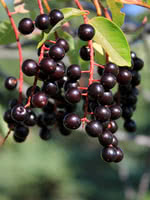Mon-Fri 9am - 5pm Mountain time
Western Chokecherry vs Golden Spice Pear
Prunus virginiana var. demissa
Pyrus Golden Spice
NOT AVAILABLE THIS SEASON - MIGHT RETURN
Western Chokecherry is a shrub or small tree commonly used for farmstead and field windbreaks.
It produces white flowers in the spring and edible dark purple fruit that matures between September and October. Its cherries are great for making for making jams, jellies or wine, but are not very palatable for raw eating.
Golden Spice Pear produces delicious fruit and has other features that make it a striking accent tree. It is one of the few pears that successfully grows on the Canadian prairies. In late August, small, yellow pears with a slight red overlay will ripen and be ready for a variety of needs, including: fresh eating, canning, jams, and baking. They are slightly sweet with a crisp texture. Come fall, the green foliage transitions to orange, red, or burgundy, adding a burst of color to your yard.
Golden Spice Pear requires upkeep to ensure its survival and longevity. Regular pruning is recommended in late winter or early spring to maintain the oval shape and overall health of the tree. An additional pear or apple tree is required within 150 m (500’) for cross pollination and fruit production to occur.
Western Chokecherry Quick Facts
Golden Spice Pear Quick Facts
Toxicity: toxic to horses, cattle, etc.)

